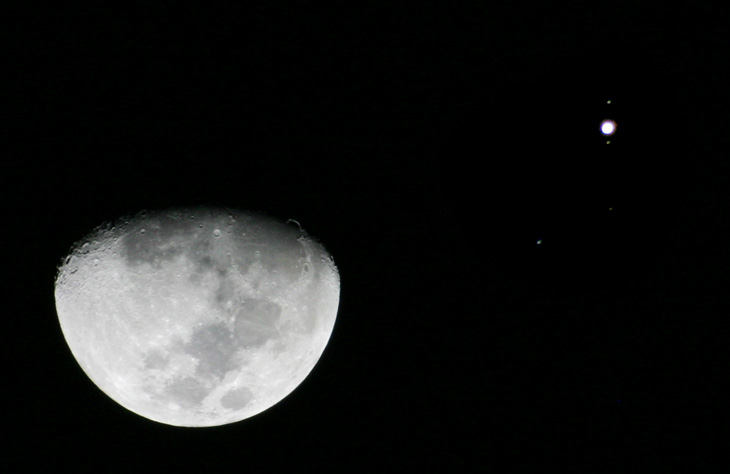
Just a quick image from tonight, as Jupiter passed close to the moon. Or at least, from the given perspective of one position in the universe presently occupied by Earth. Jupiter has often been much closer to the moon, distance-wise, even when not visible in the sky at all.
This is admittedly both not very good, and a digital composite. The reason for the composite is the wide disparity in light levels. A lot more of the light reflected from the moon reaches us than the light from Jupiter and its satellites (three of which are visible in this shot.) So the exposure time to capture our moon is many times less than that needed to capture Jupiter’s moons, and in the frame that produced the three moons shown here (from top, Ganymede, Io, and Callisto,) our moon was blown out into a featureless blob. Even Jupiter is both overexposed and showing distinctive chromatic aberration (“color fringing”) as well as some coma – I really shouldn’t attempt to use this lens for astronomical photos.
By the way, the spot that’s out of line with the others is not a moon of Jupiter, but a star – Jupiter’s satellites always appear in a line, and the third is very faintly visible below Jupiter (provided your monitor gamma is reasonably accurate) about five times as far away as the others.
Compositing astronomical images is fairly common anymore, which I find somewhat annoying, since a few years ago it was considered “Photoshopping” and a no-no. Very often when you see a detailed starfield, especially with detail in the Milky Way, over any kind of landscape, it’s digitally edited. Bringing up the detail in the faint clouds of the Milky Way requires long exposures and a tracking mount to counteract the rotation of the Earth, which would blur the foreground landscape, and depending on the light source for the landscape, the exposure values can be way too far apart. You can see a non-composited example here, and though many cameras now are better at high ISOs than the Digital Rebel (300D) I used, they’re not that much better.
But anyway, this is my quick peek at the conjunction. One of these days I’ll capture something disappearing behind the edge of the moon, but again, it will probably have to be two frames combined to see any kind of decent detail. Such is photography.




















































